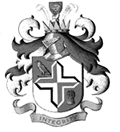 Dukinfield Centenary Souvenir
Dukinfield Centenary Souvenir
Photos of Dukinfield Town Hall and it's History
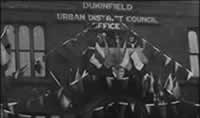 The town clerk, Charles Henry Booth, reads Dukinfield's Charter of Incorporation from a balcony erected in front of the district council offices, King Street, on September 23, 1899. With him, in top hats, are (centre) the district council chairman, Councillor William Wood; and (right) the Mayor of Ashton, Councillor Walter Newton. The town clerk, Charles Henry Booth, reads Dukinfield's Charter of Incorporation from a balcony erected in front of the district council offices, King Street, on September 23, 1899. With him, in top hats, are (centre) the district council chairman, Councillor William Wood; and (right) the Mayor of Ashton, Councillor Walter Newton. |
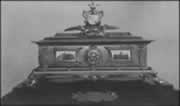 An example of the type of casket presented to Freemen of the Borough to hold the illuminated scrolls recording the distinction. Only 12 people were appointed freemen and, as the above casket is dated 1919, it must have been presented to Charles Henry Booth, Elizabeth Hannah Kenyon or Joseph Cooke. An example of the type of casket presented to Freemen of the Borough to hold the illuminated scrolls recording the distinction. Only 12 people were appointed freemen and, as the above casket is dated 1919, it must have been presented to Charles Henry Booth, Elizabeth Hannah Kenyon or Joseph Cooke. |
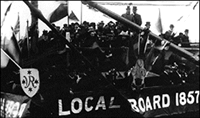 The dignitaries gather to formally lay the corner stone of Dukinfield Town Hall on September 23, 1899. The ceremony was performed by Mrs (later Lady) A.W. Nicholson of Arisaig, Inverness; the lady of the manor. It can be seen at the north west corner of the building, and bears the inscription: "This stone, laid September 23, 1899, commemorates the grant of a Charter of Incorporation to Dukinfield on the 2nd of August, 1899." The dignitaries gather to formally lay the corner stone of Dukinfield Town Hall on September 23, 1899. The ceremony was performed by Mrs (later Lady) A.W. Nicholson of Arisaig, Inverness; the lady of the manor. It can be seen at the north west corner of the building, and bears the inscription: "This stone, laid September 23, 1899, commemorates the grant of a Charter of Incorporation to Dukinfield on the 2nd of August, 1899." |
|
Crowds gather on the town hall plateau for the official opening of the building on June 15, 1901, by Alderman James Pickup. |
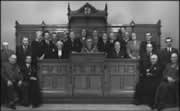 A photograph of Dukinfield Town Council taken in 1959. The photo does not say whether it was taken before or after May, but it would seem likely that the mayor is Ernest Jones. Nowadays, the council chamber has been converted into a snooker hall, but the board listing all the town's mayors remains on the wall. A photograph of Dukinfield Town Council taken in 1959. The photo does not say whether it was taken before or after May, but it would seem likely that the mayor is Ernest Jones. Nowadays, the council chamber has been converted into a snooker hall, but the board listing all the town's mayors remains on the wall. |
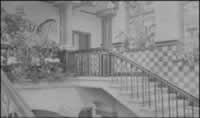 The Dukinfield Local Board offices, pictures in 1900, just before demolition. These stood at the corner of King Street and Chapel Street, opposite what is now the NatWest Bank. They were pulled down to make way for the town hall, and the spire can just be seen to the right of the left-hand chimney. The local board offices were erected in the late 1850s. The Dukinfield Local Board offices, pictures in 1900, just before demolition. These stood at the corner of King Street and Chapel Street, opposite what is now the NatWest Bank. They were pulled down to make way for the town hall, and the spire can just be seen to the right of the left-hand chimney. The local board offices were erected in the late 1850s. |
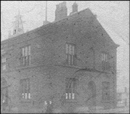 A view of the interior of the town hall just after it opened, in 1901. Almost 100 years later, the view is essentially the same, although the wall on the left of the picture now houses a connecting door to the Jubilee Hall, which was added in the mid-1930s. A view of the interior of the town hall just after it opened, in 1901. Almost 100 years later, the view is essentially the same, although the wall on the left of the picture now houses a connecting door to the Jubilee Hall, which was added in the mid-1930s. |
 Sir Charles Henry Booth, one of the most influential figures in Dukinfield's early municipal history. He was provisional town clerk when the Charter of Incorporation was granted, and went on to be a councillor, alderman, and Freeman of the Borough. He died in November, 1939, run over in the Blackout near his home on Mottram Road, Stalybridge. Sir Charles Henry Booth, one of the most influential figures in Dukinfield's early municipal history. He was provisional town clerk when the Charter of Incorporation was granted, and went on to be a councillor, alderman, and Freeman of the Borough. He died in November, 1939, run over in the Blackout near his home on Mottram Road, Stalybridge. |
 The Charter of Incorporation. The document is now part of the Tameside Local Studies Library collection. The Charter of Incorporation. The document is now part of the Tameside Local Studies Library collection. |


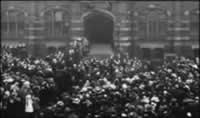 The town hall corner stone ready to be winched into position. beneath the stone is a bottle containing coins and copies of three local newspapers.
The town hall corner stone ready to be winched into position. beneath the stone is a bottle containing coins and copies of three local newspapers.